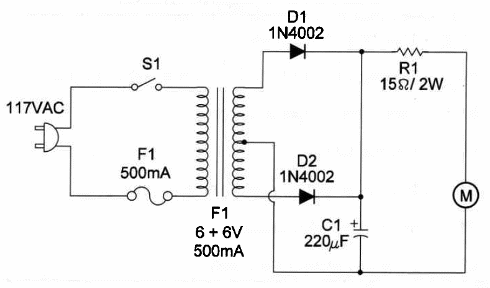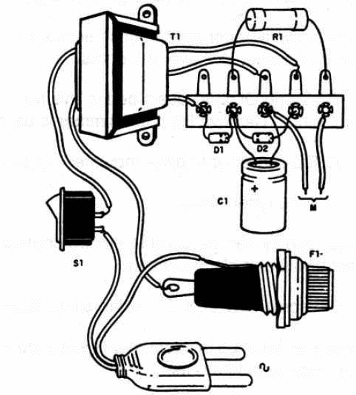A toy’s small DC motor can be used to mount a liquids shaker. The shaker can be used in chemical experiments to mix substances quickly and efficiently.
The circuit is powered from the power supply line (to avoid the expense of batteries), but there is no shock hazard because an isolation transformer is used. Of course, for fieldwork you can also power your mixer from common AA cells.
The transformer is chosen according to the motor voltage.
A four-AA-cell DC motor requires a 6+6 volt x 500 mA transformer (a 6-volt center tapped transformer).
A two-AA-cell DC motor requires a 3V x 500 mA transformer.
Secure the motor into a small cylindrical plastic box. Use a long shaft to attach a small plastic screw propeller.
Figure 1 shows the schematic diagram of the electronic part of the circuit: a power supply.

The diodes are common 50 V x 1 A silicon rectifiers, and C1 is not critical. C1 should be in the range between 100 and 1,000 µF.
Figure 2 shows a mechanical view, using a small terminal strip as chassis.

The fuse is important to avoid severe troubles if shorts occur.
R1 is a current-limiting resistor and can be altered according to the motor.
Values between 4.7 and 100 Ω can be experimented with for better performance.
Position of the polarized parts, such as the diodes and electrolytic capacitor, should be observed.
Remember that the motor rotates clockwise or not according to the voltage polarization.
Liquids Shaker
D1, D2 - 1N4002 silicon diodes
T1 - Transformer: 117 VAC: 6+6V x 500 mA - see text
S1 - SPST slide or toggle switch 7
F1 - 500 mA fuse
C1 - 220 UP, 16 WVDC electrolytic capacitor
R1 - 15 ohm, 2 W, 5% resistor
M - small DC motor (3 to 6 volt)
Ideas to Explore
To learn more about circuit and devices or to get better performance:
Alter R1 to achieve better performance according to the DC motor used. Try values between 4.7 and 100 Ω.
Use the DCLamp Dimmer described in this book to get a speed control for the motor. Remove R1 if the dimmer is used.
Use the 6V DC converter to get a regulated output from the circuit.
Science projects and uncommon uses:
This power supply can be used in electro-chemical experiments, such as electrolysis and electroplating.
Replace the screw propeller with a tan blade. Experiment.
The device can be used in experiments involving water currents in small places, such as aquariums.
Other applications that require controlled movement of a small DC motor can use this circuit.



